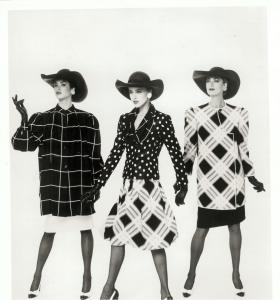Bill Blass' Place in History
From Nancy Reagan to celebrities of today, Bill Blass' fashions have refined the "American look" with their distinctly Midwestern no-fuss aesthetic. Blass' place in history also goes beyond dressing America as he played an important part during WWII as a member of the Ghost Army, earning him a Congressional Gold Medal and the first CFDA Humanitarian award.
On his 100th birthday, his hometown of Fort Wayne, Indiana, honored his contributions to American fashion and WWII with 100 days of exhibits featuring sketches and designs, events, and celebrations.
Walk In Bill's Shoes
Many of those tributes are available to view throughout our community, including:
• Enjoy Bill Blass Metal Sculptures, created from his original design sketches, located at
• 303 E Main Street in front of the Arts United Center
• 300 E Main Street in front of the ArtsLab
• 850 S Barr Street near the History Center
• 900 Library Plaza at the Downtown branch of the Allen County Public Library
These sculptures are a permanent addition to Fort Wayne’s public art scene, created by local metal sculpture artist Greg Mendez.
• Stroll down “Bill Blass Runway” an alley running next to 816 Pint and Slice, named in Bill’s honor.
• Visit the Veteran’s National Museum, located at 2122 O’Day Rd. The memorial shrine and museum is home to an exhibit highlighting Blass’ WWII Ghost Army experience. You can also purchase a Ghost Army Commemorative Coin.
• Stroll past Blass’ childhood home, located at 3618 S Calhoun St. Now a private home, you can drive by and spot the permanent ARCH-approved historical/educational plaque.
• While there, check out South Side High School, located at 3601 S Calhoun St. South Side is Bill Blass’ alma mater – he was a 1940 graduate.
• Cross the Bill Blass Bridge, located on Bostick Rd. This Historic bridge transformation now has an iconic name – and is a beautiful space for reflection and unique photo opportunities.
Bill Blass’ Connection to Fort Wayne
Bill Blass was born and raised in Fort Wayne, Indiana on June 22, 1922. He grew up in a house on South Calhoun, across from South Side High School with his one sibling, an older sister named Virginia. When he was 5 years old, Bill’s father took his life. In his autobiography Bare Blass, Bill wrote, “My mother supported us with money she earned by dressmaking which she did with decent success in a spare room in our house on South Calhoun Street.”
As a young boy, Bill spent hours reading fashion magazines and going to the local movie house with friends, noting the costumes that actresses wore. He took the trolley across town to art classes to sharpen his sketching skills. When he was fifteen, he began selling sketches of evening dresses for $25 to Kalmour, a manufacturer in New York.
“In retrospect, I can see how certain influences of my childhood and youth entered my unconsciousness and remained there, like a fine fog, while I steered unaware, and apparently grinning, toward the only city I ever have ever wanted to live in (New York) to do the only thing I have ever wanted to do (fashion),” wrote Bill in Bare Blass.
Bill Blass’ Place in Fashion History
Blass is best known for being one of the premier American designers of the 20th century. He produced signature simple yet striking designs that were distinctly American and clearly tied to his upbringing in the relaxed and conservative Midwest. He helped refine the “American Look” that other designers’ empires were built upon. Blass never wandered from his roots, producing elegant garments coveted by some of America’s leading ladies, including Gloria Vanderbilt, Liza Minnelli, and Jackie Kennedy.
Success was not immediate for Blass, “I drew my first sketch of my corporate logo in 1944 while lying on a bunk in Luxembourg, then it would be another fifteen years before I would have a product to put it on, and another ten after that before I had my own name on the door. Patience is something I know a lot about,” wrote Bill in Bare Blass.
Bill Blass’ Involvement in the Ghost Army
Bill’s career path took a detour during World War II when he joined the army in 1942. He became a member of the 603rd Engineer Camouflage Battalion, eventually known as the Ghost Army.
The battalion’s sole mission was to deceive the Germans about the location and strength of American troops on battlefields across Europe. Bill and his fellow soldiers designed and produced elaborate ploys, including inflatable tanks, trucks, jeeps, and airplanes, as well as sound trucks, phony radio transmissions, and temporary campsites. These deceptions provided critical support as the Allied front lines moved eastward after D-Day luring German forces away from the fighting units’ true locations.
The Ghost Army’s operations and contributions were never honored because their story remained classified for over 40 years. On February 1, 2022, The Ghost Army Congressional Gold Medal Act was signed by the president following a seven-year campaign to honor these brave men. Of the more than 1,100 members of the Ghost Army, only 10 survive today. In 2024, the legacy of Bill Blass will be honored with a Congressional Gold Medal for his service in the Ghost Army. A replica medal will be presented to his family.











